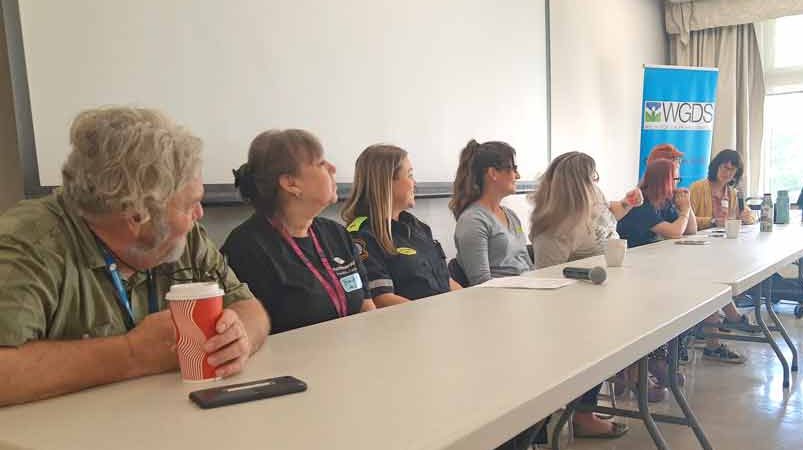ABOYNE – Using a harm reduction approach to helping people with addictions is more effective and more humane, panelists said at the “Reducing Harms, Building Community: A Wellington County Conversation” event hosted by the Wellington Guelph Drug Strategy.
About 100 people attended the half-day event on May 16 at the Wellington County Museum and Archives.
Most attendees are employed by agencies that work with people with addictions, but there were also many who have lived experience of addiction in attendance.
“The intent today is to bring people together to learn what resources are available and to understand what we mean when we use a harm reduction approach,” said drug strategy executive director Jean Hopkins in her opening remarks.
In simple terms, harm reduction is adding safety measures or removing things that are a potential risk.
Wearing seatbelts is harm reduction; crossing guards at schools are harm reduction; life jackets in boats is another example.
When it comes to addiction, harm reduction can mean safe injection sites or places to discard used needles.
For Tonya Evans and Denise Watterson, reducing stigma and making choices about language is another way to reduce harm for individuals with addictions who are seeking help.
Evans is a peer navigator with the Canadian Mental Health Association Waterloo-Wellington and Watterson a site facilitator.
The stigma around addictions is not just being shunned by neighbours or scowled at by strangers.
It’s also in hospitals, the criminal justice system and social services, they said.
“We have a judgmental healthcare system,” Evans said. “It is not harm reduction based. And a big way to reduce harm is language.”
Rather than saying someone has been “clean” or “sober,” say they have been “practicing abstinence.”
Every AA meeting starts with participants saying they are an alcoholic.
“It implies we are less worthy when we’re forced to say that,” she said. “I’d rather say ‘I am a human that uses substances to deal with trauma and pain.’”
Watterson noted the underground drug supply is often tainted with fentanyl these days.
So rather than saying someone “died from an overdose” or an “accidental drug death,” it’s more accurate to say they “were poisoned by drugs.”
Don’t say “street drugs.” Use “unregulated drug supply” instead. Don’t say “relapse.” Use “change in their experience” instead.
“Shifting language is hard so go easy on yourself,” Watterson advised. “Harm reduction is the undoing of powerlessness.”
Many treatment options are focused on abstinence rather than harm reduction and social programs require the recipient to be drug- and alcohol-free to receive benefits.
These are barriers that often keep people from seeking help, they said.
Elsa Mann is a team lead with the Rural Wellington Community Team with the Mount Forest Family Health Team and Maddy Smith is a community worker with the Legal Clinic of Guelph-Wellington.
They told the audience that drug use and drug poisonings have occurred in rural Wellington County, even though most people think this is an urban problem.
What they are seeing is that Ontario Works and Ontario Disability Support Program barely cover the cost of rent; minimum wage is far below a living wage; and with the rising cost of food, it’s doubly difficult for someone addicted to drugs or alcohol to think about healing themselves when they can’t meet the bare necessities.
They provided a list of things that would help people with addictions, especially in rural communities:
- sharps containers;
- washrooms for the unhoused;
- physical places where people can just be, without being seen as a threat;
- transportation;
- communication about unsafe drug supplies;
- emergency food;
- more mobile services; and
- more brick-and-mortor resources.
“The stigma in the county is higher than in Guelph. It’s horrible and also harmful,” said Logan Legate, a peer worker with the Sanguen Health Centre.
“The Sanguen van is often the only place to get safe drug supplies. But people worry about being seen at the van.”
“The geography is so tough,” agreed Dawn Koehler, field superintendent of the Guelph-Wellington Community Paramedicine program.
“Getting people to appointments, to resources, is more difficult in the county.”
“Harm reduction is the most successful lane,” said Tommy Gilligan, a peer outreach worker with Stonehenge Therapeutic Community.
“We need to meet people where they’re at, but not leave them there to fend for themselves.”



